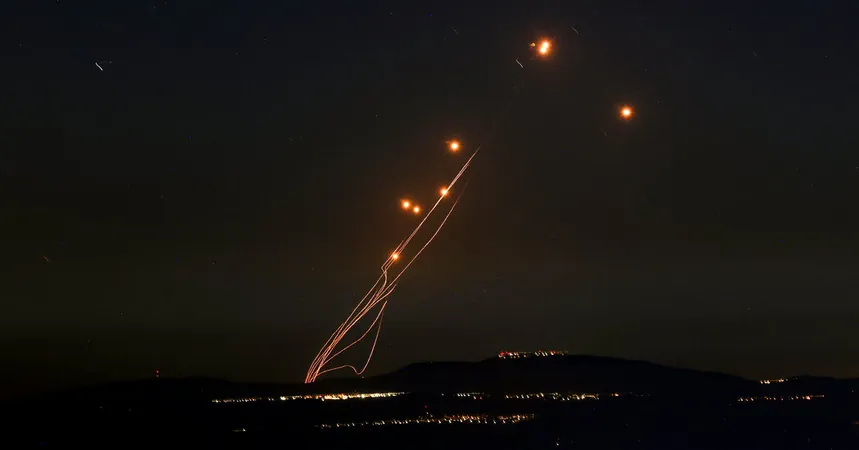
Israeli Strikes Target Hezbollah in Beirut: A Dangerous Escalation in Regional Conflict
2024-09-27
In a dramatic escalation of military tensions in the Middle East, Israel has launched airstrikes targeting Hezbollah in southern Beirut, aiming specifically at the group's leadership and infrastructure. This latest series of attacks has raised fears of a broader regional conflict that could pull Iran and other allied militias into the fray.
Prime Minister Benjamin Netanyahu made headlines with a bold address at the United Nations General Assembly, where he defiantly affirmed Israel’s commitment to pursuing military action against Hezbollah despite mounting international calls for a ceasefire. Following his speech, Israeli forces intensified their operations, conducting airstrikes on what the military describes as Hezbollah's "strategic capabilities" located beneath civilian areas in the Dahiya neighborhoods of Beirut.
Early reports indicated that at least six people lost their lives and over 90 others were injured from the strikes, with the death toll expected to rise as rescue operations continued into the rubble of destroyed residential buildings. The attacks have drawn widespread condemnation, particularly given their impact on civilian life.
Lebanon's Health Minister, Firass Abiad, lamented the scale of destruction, noting that the airstrikes hit densely populated residential zones traditionally associated with Hezbollah's control. “They were filled with people. Whoever is in those buildings is now under the rubble,” Abiad remarked, highlighting the tragic reality of civilian casualties in conflict zones.
The Israeli military spokesperson, Rear Admiral Daniel Hagari, justified the strikes as a necessary act of defense, accusing Hezbollah of embedding their military capabilities within civilian neighborhoods and using locals as human shields. Israeli officials reported ongoing operations to disrupt munitions transfers to Hezbollah, including patrols of warplanes near Beirut's international airport.
Tensions were further inflamed by Hezbollah's ongoing rocket fire into northern Israel, which escalated shortly after Hamas's attack on Israel on October 7. The reciprocal combat has already displaced over 160,000 individuals from their homes, encompassing both sides of the Israeli-Lebanese border.
As the situation deteriorates, Lebanon's caretaker Prime Minister Najib Mikati announced his intention to cut short his trip at the U.N., arguing that Israeli actions illustrate a blatant disregard for international appeals for restraint. Meanwhile, Netanyahu's steadfast refusal to entertain ceasefire negotiations indicates that Israeli operations may ramp up, as the military focuses its attention on neutralizing perceived threats from Hezbollah.
In response to the strikes, Iranian officials convened an emergency meeting, with senior figures declaring that Israel had "opened the gates of hell against itself" and warning that a coordinated response from pro-Iranian militias was forthcoming.
Adding another layer to the conflict, the ongoing war in Gaza continues to claim lives, with the Gazan Health Ministry reporting over 41,000 fatalities since hostilities began, exacerbating the humanitarian crisis.
Hezbollah's leader, Hassan Nasrallah, remains a significant figure amidst this chaos. Known for his powerful rhetoric and complex history, he has been critical of Israel's actions, often framing the conflict as a fight for Muslim and Arab rights in the face of Zionist occupation. Since assuming leadership, he has played a pivotal role in regional dynamics, including interventions in Syria and training allied militias.
As military exchanges between Israel and Hezbollah persist into the night, with alarming reports of further rocket fire and retaliatory airstrikes, the international community watches closely, fearing that this conflict could spiral beyond control, leading to a catastrophic wider war engulfing the region.
What Lies Ahead?
As Israel persists in its military objectives, questions loom large about the sustainability of continued assaults and the potential for broader multi-front conflicts emerging, fueled by longstanding animosities and complex regional alliances. How long can both sides sustain this level of aggression? The answer remains uncertain, but the stakes have never been higher.


 Brasil (PT)
Brasil (PT)
 Canada (EN)
Canada (EN)
 Chile (ES)
Chile (ES)
 España (ES)
España (ES)
 France (FR)
France (FR)
 Hong Kong (EN)
Hong Kong (EN)
 Italia (IT)
Italia (IT)
 日本 (JA)
日本 (JA)
 Magyarország (HU)
Magyarország (HU)
 Norge (NO)
Norge (NO)
 Polska (PL)
Polska (PL)
 Schweiz (DE)
Schweiz (DE)
 Singapore (EN)
Singapore (EN)
 Sverige (SV)
Sverige (SV)
 Suomi (FI)
Suomi (FI)
 Türkiye (TR)
Türkiye (TR)